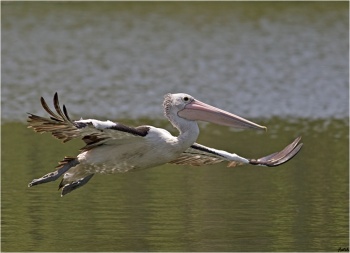- Pelecanus conspicillatus
Identification
Length 160-180 cm, (70-71 in.) wingspan 230-260 cm, (90-91 in.) and weight 4-6.8 kg.
Mainly white, with black tail, primaries, secondaries and inner secondary coverts; also a narrow black wingbar on underside of wing. Very large pale, pinkish bill; dark eye with pale yellow or white eye ring.
Distribution
Australia and Tasmania; winters to New Guinea region
Taxonomy
This is a monotypic species[1].
An extinct subspecies P. c. novaezealandiae has been described from subfossils in New Zealand[2].
Habitat
Marine and freshwater environments, lakes and rivers.
Behaviour
Breeding
They nest communally. The nest is a shallow depression in earth or sand, sometimes with some grass lining. Up to three chalky white eggs are laid.
Diet
The diet includes fish.
References
- Clements, J. F., T. S. Schulenberg, M. J. Iliff, D. Roberson, T. A. Fredericks, B. L. Sullivan, and C. L. Wood. 2014. The eBird/Clements checklist of birds of the world: Version 6.9., with updates to August 2014. Downloaded from http://www.birds.cornell.edu/clementschecklist/download/
- Scarlett, R. J. (1966). A Pelican in New Zealand. Notornis 13: 204-217.
- Wikipedia
- BF Member observations
Recommended Citation
- BirdForum Opus contributors. (2025) Australian Pelican. In: BirdForum, the forum for wild birds and birding. Retrieved 26 April 2025 from https://www.birdforum.net/opus/Australian_Pelican
External Links
GSearch checked for 2020 platform.1





